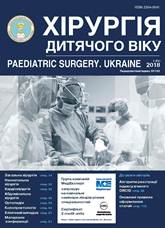Dependence of the rate of stress-induced ulcers on acidity of gastric juice in the post-surgery period in children
DOI:
https://doi.org/10.15574/PS.2018.59.51Keywords:
stress-induced mucosal disease, ulcer, erosion, gastrointestinal tract, gastric juice pH, surgeryAbstract
Objective: to analyse the dependence of stress-induced erosive and ulcerous changes of the gastrointestinal mucosa (GIMCs) in the post-surgery period on the acidity level of gastric juice.Material and methods. In children with surgical pathology in the pre-surgery period and in 3 days after the operation, fibroesophagogastroduodenoscopy was performed using the Olimpus Evis Lucera CLV-260SL apparatus (Olimpus, Japan); the acidity of the intragastric contents was determined by using the acidogastrograph АГ-1рН-М (manufactured by Start LLC, Ukraine), which was provided during the endoscopic studies and intraoperative express monitoring.
Results. GIMCs were detected in 25 children in the post-surgery period that made up 33.3% of all examined patients. The dynamics of intragastric pH was as follows: mean pH for all patients – 4.09; mean pH for the patients with GIMCs – 3.48; mean pH for the patients without manifestations of GIMCs – 4.35. The gastric juice pH value during the intraoperative monitoring in patients with manifestations of GIMCs in the post-surgery period was on average 2.05+/-0.23 (р=0.0001), while in patients without the postoperative GI complications – 3.42+/-0.97 (р=0.0001).
Conclusions. The GIMCs rate in the post-surgery period in children is 33.3%, which determines the relevance of the chosen direction of the research. A significant factor in the formation of stress ulcers and erosions is also the acidity of gastric juice with a tendency to lower pH values in patients with GIMCs.
References
Kulakova E.V. (2015). Posleoperatsionnyie ostryie erozii i yazvyi – ih kliniko-biohimicheskiy prognoz. Avtoref. dis. kand. med. nauk. Saratov.
Kurbonov H.H. (2014). Endoskopicheskaya diagnostika i lechenie posleoperatsionnyih zheludochno-kishechnyih krovotecheniy. Avtoref. diss. kand. med. nauk. Moskva.
Hohlova E.E. (2016). Kliniko-morfologicheskaya harakteristika ostryih eroziy, yazv zheludka i dvenadtsatiperstnoy kishki v bolnyih terapevticheskogo i nevrologicheskogo profilya. Avtoref. diss. kand. med. nauk. M.
Abaitua Bilbao J.M., Manzanos Gutierrez J. (2014, Jan). Digestive hemorrhages and urological surgery. Apropos of 11 cases. Acta Urol Belg. 42(1): 7-27.
Brunton L.L., Chabner B.A., Knollmann B.C. (2015). Goodman and Gilmans pharmacological basis of therapeutics. 12th Edition. McGraw-Hill. Medical Publishing Division: 1648.
Conrad S.A., Gabrielli A., Margolis B. et al. (2015, Apr). Randomized, double-blind comparison of immediate-release omeprazole oral suspension versus intravenous cimetidine for the prevention of upper gastrointestinal bleeding in critically ill patients. Crit Care Med. 33(4): 760-5. https://doi.org/10.1097/01.CCM.0000157751.92249.32
Yang Y., Metz. D. (2016). Safety of proton pump inhibitor exposure. Gastroenterology. 139: 1115–1127. https://doi.org/10.1053/j.gastro.2010.08.023; PMid:20727892
Downloads
Issue
Section
License
The policy of the Journal “PAEDIATRIC SURGERY. UKRAINE” is compatible with the vast majority of funders' of open access and self-archiving policies. The journal provides immediate open access route being convinced that everyone – not only scientists - can benefit from research results, and publishes articles exclusively under open access distribution, with a Creative Commons Attribution-Noncommercial 4.0 international license(СС BY-NC).
Authors transfer the copyright to the Journal “PAEDIATRIC SURGERY.UKRAINE” when the manuscript is accepted for publication. Authors declare that this manuscript has not been published nor is under simultaneous consideration for publication elsewhere. After publication, the articles become freely available on-line to the public.
Readers have the right to use, distribute, and reproduce articles in any medium, provided the articles and the journal are properly cited.
The use of published materials for commercial purposes is strongly prohibited.

